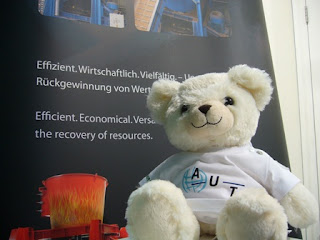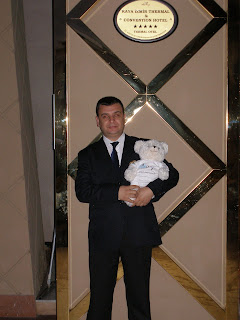Location: Shanghai, China 
After three hours of driving to Munich airport, six hours of flying from Munich to Dubai, four hours of waiting for our connecting flight, and another eight hours of flying, my colleague and I finally arrived in Shanghai on March 5th last week. It was afternoon in China and since I pretty much stayed up all night, I desperately wanted to go to bed. Thankfully, as we took the transrapid train from the airport which felt a bit like flying, as we were going about 430 km/h, we arrived at the hotel very quickly. My first meal in Shanghai I had at a small takeaway with steamed-up windows and it consisted of a bowl of rice, chicken feet, egg yolk soup and vegetables. Trust me, it sounds worse than I thought.


The reason I actually ended up in Shanghai is that I joined a colleague of mine who was presenting the company she works for at the IE expo 2012, a trade show within the environmental and waste management industry. The trade show was very interesting and there were loads of interested people from China, but also Japan, India, Mongolia and from other countries visiting our booth. In addition to exhibitors introducing technologies for the complete treatment or sorting of solid waste, there were a lot of Chinese and German companies that provide equipment and filtering systems for water cleaning. In fact, waste water and contaminated is a huge issue in China, as there are still many production facilities that simply feed their chemicals into rivers and lakes or that store toxic residues in riversides.
However, the trade show is one of the first signs of a gradually increasing environmental awareness in China and a step towards the realisation of scheduled government efforts. The 12th Five-Year plan predominantly refers to ecological sustainability including energy and resource efficiency, climate change and the reduction of environmental pollution to a minimum. With regard to its environmental orientation, this Five-Year plan supports the targets proposed by China just before the United Nations Climate Change Conference in 2009, which include the reduction of green house gasses by 40 to 45 percent by 2020 compared to the level in 2005. In order to support China in the implementation of its aim, I will probably join my colleague on a few more trips to trade shows in Shanghai.
 However, this post is not supposed to be (entirely)
about my lack of direction, but primarily about one of the things that
fascinated me most about Tokyo:
the transportation system, more precisely the metro or subway. I’m sure you’ve
seen the pictures: crammed cabins and more people squashing in as supervisors
are trying to push the crowd further back from the doors in order for them to
close properly. It’s not just pictures, it’s real. On average, more than 6.33
million people use the subway routes of one of Tokyo’s
major subway companies every day. Just a reminder, more than 13 million people
live in the Tokyo Metropolitan Area (TMA). Now, this would mean that nearly
half of Tokyo’s
population uses the rail system (of one transport company!) on a daily basis.
Naturally, during commuting time, subways are incredibly crowded. Once I
actually happened to get on a subway during working hours and I was really surprised
about how empty it was. I assume only a handful of passengers that use the
underground every day have ever actually had a chance to sit down.
However, this post is not supposed to be (entirely)
about my lack of direction, but primarily about one of the things that
fascinated me most about Tokyo:
the transportation system, more precisely the metro or subway. I’m sure you’ve
seen the pictures: crammed cabins and more people squashing in as supervisors
are trying to push the crowd further back from the doors in order for them to
close properly. It’s not just pictures, it’s real. On average, more than 6.33
million people use the subway routes of one of Tokyo’s
major subway companies every day. Just a reminder, more than 13 million people
live in the Tokyo Metropolitan Area (TMA). Now, this would mean that nearly
half of Tokyo’s
population uses the rail system (of one transport company!) on a daily basis.
Naturally, during commuting time, subways are incredibly crowded. Once I
actually happened to get on a subway during working hours and I was really surprised
about how empty it was. I assume only a handful of passengers that use the
underground every day have ever actually had a chance to sit down.


























